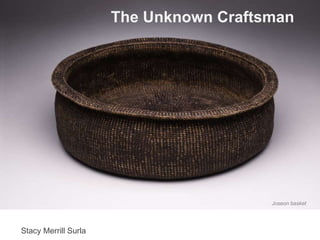
The Unknown Craftsman
- 1. The Unknown Craftsman Stacy Merrill Surla Joseon basket Stacy Merrill Surla
- 2. Japanese folk art theory is a model for thinking about masterworks Kenzan-style tea bowl
- 3. Usefulness, material, technique Early Showa / Taisho era textile
- 4. 3 Genius in the ordinary Joseon rice washing bowl
- 5. 4 In masterworks we should be looking for qualities, not personalities Seattle Library
- 6. 5 What’s a masterwork in mingei theory? Joseon Gohon tea bowl
Notas do Editor
- I have two points to make. The first is that Japanese folk art theory is a model for thinking about masterworks. Soetsu Yanagi, who founded the Japanese Folk Crafts Museum in the 1930s, introduced the concept of mingei: “hand crafted art of ordinary people.”
- Mingei objects can be stunningly beautiful. But they weren’t made to express beauty. They’re practical things whose principle purpose is to fulfill the needs of ordinary people. Their beauty is in how beautifully they work – and also derives from the beautiful way in which they are made. According to the mingei model, our masterworks should consider and respond to the limitations every craftsperson must consider: The purpose for which a given article is used The nature of the materials employed And the use of appropriate techniques. According to Yanagi, “Usefulness, material, and technique, if given their due values, automatically give us calm and friendly beauty in the crafts we use from day to day.”
- As Yanagi pointed out, not all living people can be geniuses. The number of geniuses appearing in any given generation is actually extremely small. And yet he saw, for instance in the anonymous work of Chinese Sung potters a thousand years ago, and in the work of modern Korean woodworkers, pieces of art of the highest quality produced in mass quantities for everyday use.
- The second point is, in masterworks we should be looking for qualities, not personalities. Remember Joshua Prince-Ramus’ keynote at the 2007 IA Summit? He spoke against the idea of the architect as someone whose role is to deliver the “master stroke.” Instead, the architect is there to serve the program, and maybe to re-engineer the design process. I’ve always loved the humility in that idea. I try to express it to my clients and teammates. I’m an information architect, and I’m not here to deliver you all my stroke of genius. I’m here to co-design with you and help make this thing work for you, beautifully.
- A masterwork for me would be something that: Comes from and is made for people Is not a one-off, but is replicable to different scales and large quantities Is functional in daily life And is made with humility and in a spirit of joy.
